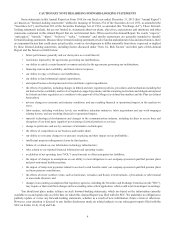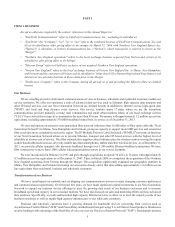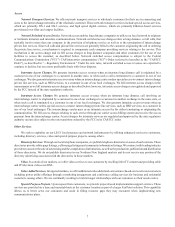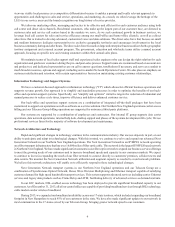FairPoint Communications 2013 Annual Report Download - page 11
Download and view the complete annual report
Please find page 11 of the 2013 FairPoint Communications annual report below. You can navigate through the pages in the report by either clicking on the pages listed below, or by using the keyword search tool below to find specific information within the annual report.9
view our visible local presence as a competitive differentiator because it enables a prompt and locally relevant approach to
opportunities and challenges in sales and service, operations, and marketing. As a result, we often leverage the heritage of the
LECs in our service areas and the brand recognition our long history of service provides.
We tailor our marketing offers, messaging and tactics to be effective and efficient for each customer audience using both
call center and direct sales channels. Residential customers, who make up the largest part of our customer base, are directed to
customer sales and service call centers based in the markets we serve. As we seek continued growth in business services, we
leverage local call centers for sales and service efficiency among our small-office and home-office clientele, as well as a direct
sales force that is trained to develop advanced, customized voice and data solutions. The direct sales force that focuses on small
and medium businesses dedicates representatives to exclusive geographic territories and encourages involvement in the local
business community during and after hours. The direct sales force focused on large and enterprise business utilizes both a geographic
territory assignment and a named account program. The government, education and wholesale teams utilize a named account
approach, focusing on specific new and existing customers within their annual sales plans.
We maintain teams of local sales support staff and experienced sales engineers who can design the right solution for each
organization and guide new customers during the pre- and post-sales process. Support teams are customized based on account size
and product set, and dedicated representatives are on call to answer questions, troubleshoot if necessary, and serve as a conduit to
much broader resources, options and support, including our in-market Network Operations Center. We also place an emphasis on
customer satisfaction and retention, with certain representatives focused on maintaining existing customer relationships.
Information Technology and Support Systems
We have a customer-focused approach to information technology ("IT") which allows for efficient business operations and
supports revenue growth. Our approach is to simplify and standardize processes in order to optimize the benefits of our back-
office and operation support systems. Specifically, our "simplify and optimize" initiative targets the reduction of redundant and
manual processes to reduce cycle times, improve efficiency and deliver enhanced customer service.
Our back-office and operations support systems are a combination of integrated off-the-shelf packages that have been
customized to support our operations as well as software as a service solution. Our Northern New England operations carrier access
billing and our Telecom Group billing operations are supported by outsourced third-party platforms.
Our systems are supported by a combination of employees and contractors. Our internal IT group supports data center
operations, data network operations, internal help desk, desktop support and phases of the systems development life cycle. We use
professional services firms for the majority of software development and maintenance.
Network Architecture and Technology
Rapid and significant changes in technology continue in the communications industry. Our success depends, in part, on our
ability to anticipate and adapt to technological changes. With this in mind, we continue to evolve and expand our advanced Next
Generation Network in our Northern New England operations. The Next Generation Network is an IP/MPLS network operating
on a fiber transport infrastructure that has over 16,000 miles of fiber optic cable. This network is the largest IP/MPLS based network
in Northern New England. We have made significant investments in our fiber optic network to expand our business service offerings
to meet the growing needs of our customers and to increase broadband speeds and capacity in our consumer markets. We expect
to continue to invest in expanding the reach of our fiber network to connect directly to customers' premises, cellular towers and
data centers. We monitor the Next Generation Network utilization and augment capacity as needed to avoid network problems.
We believe this network architecture will enable us to efficiently respond to these technological changes.
Next Generation Network transport systems in our Northern New England operations and our Telecom Group are a
combination of Synchronous Optical Network, Dense Wave Division Multiplexing and Ethernet transport capable of satisfying
customer demand for high speed bandwidth transport services. This system supports advanced services including carrier Ethernet
services and legacy data products such as Frame Relay and ATM, facilitating delivery of advanced services as demand warrants.
In our LEC markets, DSL-enabled access technology has been deployed to provide significant broadband capacity to our
customers. As of December 31, 2013, all of our central offices are capable of providing broadband services through DSL technology,
cable modem and/or wireless broadband.
During 2013, we expanded our broadband availability across our 17-state territory, which included expanding our broadband
footprint in New Hampshire to reach 95% of our customers in the state. We have also made significant updates to our network in
rural communities in the 17 states served by our Telecom Group, bringing greater network speed to our customers.
























